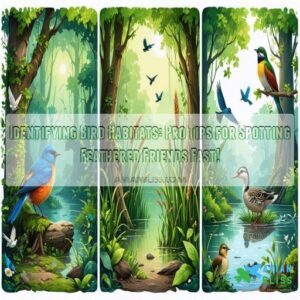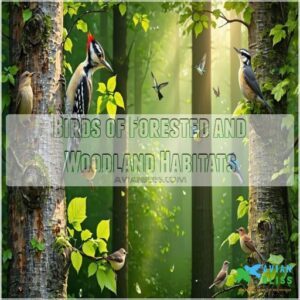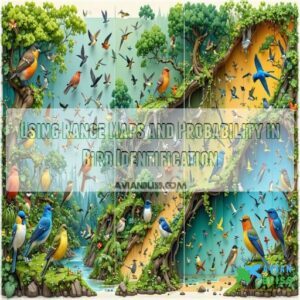This site is supported by our readers. We may earn a commission, at no cost to you, if you purchase through links.

Woodland canopies offer layered sanctuaries for songbirds, while wetland shrubs create perfect hiding spots for waterfowl.
You’ll quickly learn that vegetation density, structure, and composition are your secret weapons.
Water sources and food availability are critical clues that’ll help you narrow down potential bird species. Look for insects, seeds, and fruits that signal prime bird real estate.
By understanding how vegetation supports different bird species, you’ll transform your birdwatching from guesswork to expert-level observation.
Table Of Contents
- Key Takeaways
- Types of Bird Habitats
- Birds and Their Habitats
- Habitat-Specific Bird Species
- Identifying Birds by Habitat
- How to Identify Bird Habitats by Vegetation
- The Importance of Habitat in Bird Identification
- Using Range Maps and Probability in Bird Identification
- EBird and Refining Identification Skills
- Common Mistakes in Bird Identification
- Refining Your Bird Identification Skills
- Frequently Asked Questions (FAQs)
- What are the different environments for birds?
- How can I identify a bird in my yard?
- Does bird abundance vary with the number of trees in a habitat?
- What tools help me identify unfamiliar vegetation?
- How do invasive plants impact bird habitats?
- Can landscape changes affect local bird populations?
- Do urban gardens support diverse bird species?
- Why do some habitats attract more birds?
- Conclusion
Key Takeaways
- You’ll unlock bird habitat secrets by carefully observing vegetation density, structure, and composition, which act as nature’s roadmap to identifying feathered residents.
- Different habitats—from dense forests to open scrublands—support unique bird species, so you’ll need to match vegetation types with specific avian adaptations and behaviors.
- Water sources and food availability are critical clues that will help you narrow down potential bird species, transforming your birdwatching from guesswork to expert-level observation.
- You’ll improve your identification skills by using tools like eBird, range maps, and systematic observation techniques that track seasonal changes and habitat-specific bird distributions.
Types of Bird Habitats
Gain a deeper understanding of bird habitats and become a savvy birder.
By understanding the unique landscapes where birds live, you’ll quickly learn how to spot feathered friends faster and more accurately.
Forested and Woodland Habitats
Step into the lush world of forested and woodland habitats, where bird songs echo through layered canopies.
Explore how different tree types create unique microhabitats for feathered residents.
From towering conifers to dense deciduous woodlands, each forest floor and understory offers a treasure trove of bird life waiting to be discovered by keen observers.
Aquatic Habitats
Nestled between water and land, aquatic habitats teem with bird life uniquely adapted to wetland environments.
Your bird habitat identification skills will soar as you learn about shoreline species and their intricate relationships with pond life.
Wetland vegetation provides essential shelter, while water bird adaptations reveal nature’s ingenious survival strategies.
Scrub Shrub and Open Habitats
Step into the unique environments of scrub-shrub and open habitats, where birds thrive in unique, challenging environments. These dynamic landscapes demand keen observation and adaptive skills from their feathered inhabitants.
- Sparse, low-growing vegetation defines scrubshrub habitats
- Open landscapes provide minimal cover for birds
- Vegetation density varies dramatically between habitat types
- Specialized adaptations help birds survive harsh conditions
- Identification relies on understanding subtle environmental cues
Urban and Farmland Habitats
Urban concrete jungles might seem bird-free, but these adaptable feathered friends have mastered city living.
Pigeons, sparrows, and finches thrive in our urban habitats, turning rooftops and parks into their personal territories.
Farmland birds like Barn Owls and Eastern Meadowlarks navigate agricultural landscapes, showcasing remarkable habitat flexibility and survival skills.
Their presence tells a story of resilience and adaptation.
Birds and Their Habitats
Peering through binoculars, bird enthusiasts quickly learn that understanding bird habitats is the secret sauce of successful identification. Birds and their habitats share an intricate dance of survival, adaptation, and connection. Your journey into avian bliss requires keen observation and appreciation of these complex relationships.
Habitat destruction, such as forest fragmentation, has a significant impact on the delicate balance between birds and their habitats.
Key insights about birds and their habitats include:
- Habitat clues reveal critical information about bird behavior and survival strategies
- Seasonal changes dramatically impact bird distribution and habitat preferences
- Migration patterns demonstrate remarkable adaptability of different bird species
- Conservation efforts depend on understanding precise habitat requirements
Every habitat tells a story – from dense forests to open grasslands, birds have evolved remarkable specializations that allow them to thrive in specific environments. Their survival depends on perfectly matched interactions between physical characteristics, food sources, and environmental conditions.
Habitat-Specific Bird Species
You’ll find that different habitats host unique bird species, each perfectly adapted to their specific environment.
By learning to recognize vegetation types and landscape characteristics, you’ll quickly narrow down which feathered friends are likely to call a particular habitat home.
Birds of Forested and Woodland Habitats
Woodpeckers, nuthatches, and warblers transform forest environments into symphonies of life.
These canopy dwellers and understory specialists navigate woodland habitats with remarkable precision, revealing intricate survival strategies.
Their unique forest bird songs and nesting behaviors reflect specialized adaptations to different vertical layers of forest ecosystems, from dense ground cover to leafy canopies.
Birds of Aquatic Habitats
When diving into aquatic habitats, you’ll discover a world of fascinating waterbirds uniquely adapted to wetland environments. These feathered specialists thrive in diverse watery landscapes, each with remarkable survival strategies:
- Herons and egrets with razor-sharp bill designs for spearing fish
- Terns performing aerial fishing techniques with precision
- Ducks sporting waterproof feathers and specialized webbed feet
- Rails moving through dense marsh vegetation with remarkable stealth
- Shorebirds utilizing long legs for wading and probing muddy shorelines
Birds of Scrub Shrub and Open Habitats
From wetlands to open landscapes, scrub-shrub and open habitats host a diverse array of feathered inhabitants.
Accurately identifying bird species with a scrub bird identifier will help you recognize meadowlarks perching on fence posts, grasshopper sparrows blending with low vegetation, and upland sandpipers traversing expansive grasslands.
Each habitat tells a unique story of avian adaptation and survival.
Identifying Birds by Habitat
When you’re out birdwatching, understanding habitat vegetation is your secret weapon for quick identification.
You’ll quickly spot feathered friends by learning how different plants and trees create unique environments.
These unique environments attract specific bird species.
Using Vegetation to Identify Bird Habitats
After mastering habitat-specific bird species, you’ll want to zero in on vegetation clues.
Bird habitat plants tell a rich story about potential feathered residents.
Different vegetation types—from dense shrubs to sparse grasslands—signal which birds might call that space home.
Spotting key vegetation becomes your secret weapon in identifying bird habitats across regional variations.
Role of Vegetation in Bird Habitats
Vegetation plays a vital role in defining bird habitats, acting as a complex ecosystem that supports avian life.
Here’s how vegetation shapes bird environments:
- Provides essential camouflage for birds seeking protection from predators
- Creates critical nesting sites and shelter for different species
- Supplies diverse food sources through insects, seeds, and fruits
- Supports ecological balance through processes like pollination and seed dispersal.
Types of Vegetation in Different Habitats
When sizing up bird habitats, your botanical detective skills matter big time.
Different vegetation types offer critical clues about potential feathered residents.
Coniferous forests boast needle-laden landscapes, while deciduous woods showcase leafy canopies. Scrub zones feature low, dense bushes, and wetlands showcase reedy expanses.
Each plant community signals unique bird species waiting to be discovered.
How to Identify Bird Habitats by Vegetation
When you’re out bird watching, the vegetation around you is like a secret map to feathered friends waiting to be discovered.
By learning to read the landscape’s green clues—from tree density to understory composition—you’ll quickly train your eye to spot which bird species are likely hanging out in that specific habitat.
Observing Vegetation Types and Densities
A seasoned birdwatcher knows vegetation density is your secret weapon in habitat identification.
- Scan the canopy layer for structural complexity
- Analyze understory plant diversity
- Classify ground cover types systematically
Understanding the role of Forest Adaptations can also be key in identifying the unique characteristics of a bird’s habitat.
Shrubland makes your bird habitat analysis go from guesswork to precision science, revealing hidden avian territories.
Noting The Presence of Water and Food Sources
By sunrise, keen birders zero in on water sources as habitat markers.
Look for ponds, streams, and wetlands where prey abundance attracts diverse bird species.
Food availability dictates foraging behavior, revealing critical habitat characteristics.
Approximately 138 wetland-dependent bird species rely on wetlands like these wetland ecosystems for breeding, nesting, and raising young. Wetland ecosystems are crucial.
Scan vegetation near water for signs of invertebrate life, noting how different bird species interact with these dynamic environments. Bird species interactions are important.
The Importance of Habitat in Bird Identification
When you’re out birdwatching, understanding a bird’s habitat is like having a secret code to quick identification.
By learning to recognize how different environments shape bird behaviors and characteristics, you’ll be able to spot and identify feathered friends with newfound confidence and precision.
How Habitat Affects Bird Behavior and Distribution
The intricate dance between habitat and bird behavior reveals fascinating ecological patterns.
Bird species adapt their lives around environmental conditions through:
- Strategic resource allocation
- Niche-specific movement patterns
- Seasonal behavioral modifications
- Specialized feeding strategies
These habitat impacts shape distribution, driving bird adaptations that optimize survival across diverse landscapes.
Human activities such as urban development and transportation affect bird populations, with artificial light studies showing impacts on bird movement and distribution.
Understanding these dynamics reveals the intricacies of avian ecological interactions.
Using Habitat to Narrow Down Identification Options
Spotting habitat clues narrows your bird identification options faster than a hawk diving for prey. Every ecosystem whispers secrets about its feathered inhabitants.
| Habitat | Vegetation Types | Typical Bird Species |
|---|---|---|
| Forest | Dense trees | Woodpeckers |
| Wetland | Reeds, grasses | Herons |
| Grassland | Low shrubs | Meadowlarks |
| Coastal | Salt-tolerant plants | Seabirds |
| Urban | Scattered trees | Sparrows |
Use range maps and seasonal changes to confirm your detective work.
Using Range Maps and Probability in Bird Identification
When you’re out birding, range maps are your secret weapon for quickly narrowing down potential species in a specific habitat.
By understanding probability and using geographic distribution, you’ll transform from a casual bird spotter to a more confident and strategic identifier of feathered friends.
You will become a more confident birder.
How Range Maps Can Help Eliminate Unlikely Species
Range maps become your secret weapon in bird identification, slicing through species confusion like a sharp field guide.
By pinpointing precise geographic distributions, these scientific snapshots reveal which birds likely inhabit your specific location.
Migration patterns and seasonal variations illuminate species overlap, helping you eliminate improbable sightings and zero in on the feathered friends most probable in your area.
Using Probability to Identify Birds Based on Habitat
After pinpointing bird habitat distributions on maps, you’ll quickly realize probability is your greatest ally in bird identification.
Not all species hang out everywhere!
Consider these habitat probability factors:
- Geographic location specifics
- Seasonal migration patterns
- Local vegetation characteristics
- Time of year
- Specific microhabitat conditions
Master these, and you’ll transform from a casual observer to a savvy birding detective, dramatically improving your habitat-based identification skills.
EBird and Refining Identification Skills
You’ll want to harness the power of eBird, a free online tool that transforms how you track and identify birds in various habitats.
By using eBird’s interactive maps and user-generated sightings, you’ll quickly refine your bird identification skills.
You’ll discover patterns that’ll make your bird-watching adventures more rewarding.
Using EBird to Track Bird Sightings and Identify Patterns
Pivoting from range maps, eBird emerges as a birder’s digital companion for tracking species sightings. This free platform transforms your observations into powerful data analysis tools.
Check out how eBird can supercharge your bird identification skills:
| eBird Feature | Birding Benefit |
|---|---|
| Checklist Program | Real-time tracking |
| Range Maps | Species distribution |
| Bar Charts | Seasonal patterns |
| User Submissions | Community insights |
| Occurrence Maps | Habitat migration trends |
Refining Identification Skills Through Practice and Observation
Once you’ve tracked birds on eBird, sharpening your identifying skills becomes the next adventure. Expert birders know practice makes perfect when spotting feathered friends.
To fine-tune your skills, pay attention to essential bird identification techniques like mastering binocular techniques.
Here are observation tips for becoming a habitat-savvy birder:
- Study field guides religiously
- Sketch bird features in notebooks
- Take photos for later comparison
- Listen to bird call recordings
- Embrace mistakes as learning opportunities
Your birding journey transforms with patient, deliberate practice.
Common Mistakes in Bird Identification
You’ll often make mistakes when identifying birds if you don’t pay close attention to habitat clues and rely solely on physical appearance.
Learning to recognize common pitfalls—like vegetation types, ignoring seasonal range maps, and rushing your observations—will dramatically improve your bird identification skills.
Overlooking Habitat Clues
Three critical habitat clues often slip past rookie birders. Overlooking vegetation types, water sources, and local ecosystem characteristics can derail your identification process.
Missed clues in bird habitat vegetation dramatically reduce your accuracy.
Expert advice emphasizes carefully observing habitat characteristics, mapping vegetation types, and understanding how specific environments shape bird distribution and behavior.
Failing to Consider Probability and Range Maps
Rookie birders often fall into the probability trap when identifying bird species. Don’t let range map errors or rare bird bias cloud your judgment.
- Neglecting geographic limitations can lead to misidentification
- Seasonal variations drastically impact bird habitat presence
- Probability is your compass in the complex world of bird identification
Virginia’s unique eBird Data Analysis can provide valuable insights into bird habitat and behavior.
Master your skills by understanding habitat probabilities and using range maps as your trusted guide.
Refining Your Bird Identification Skills
Refining your bird identification skills requires keen observation and practice in the field.
By learning to recognize habitat characteristics, vegetation types, and bird behaviors, you’ll quickly become a more confident and accurate birder.
Tips for Improving Your Bird Identification Skills
Botched bird identifications often stem from hasty observations.
Sharpen your skills by mastering key strategies:
| Skill | Technique |
|---|---|
| Observation | Note smallest details |
| Learning | Study field guides |
| Practice | Use eBird data regularly |
Patience transforms amateur birdwatching into expert-level identification. Practice patience, study habitat vegetation types, and learn seasonal changes to become a keen observer of bird species habitat.
The Importance of Practice and Patience in Bird Identification
Mastering bird identification is a journey that rewards patience. Building your skill set takes time, just like learning any intricate craft.
Here’s how to level up your birding expertise:
- Observe consistently, even when progress feels slow
- Accept imperfect identifications as learning opportunities
- Study habitat vegetation types methodically
- Document your sightings and track improvements
- Embrace the learning curve with curiosity and enthusiasm
Frequently Asked Questions (FAQs)
What are the different environments for birds?
Forests whisper, deserts roar—birds thrive everywhere.
From lush woodlands to coastal shores, you’ll discover diverse ecosystems.
where winged creatures adapt, survive, and flourish across landscapes that range from alpine peaks to marshy wetlands.
How can I identify a bird in my yard?
Look closely at the bird’s size, shape, color, and behavior in your yard.
Check its location and time of year.
Consult field guides or eBird to match your observations.
Patience and careful details help identify your feathered visitor.
Does bird abundance vary with the number of trees in a habitat?
Imagine a tree-filled landscape teeming with life!
Bird abundance indeed correlates with tree density.
More trees typically mean more diverse habitats, providing shelter, nesting sites, food sources, and increased ecological complexity for bird populations.
This leads to a higher tree density.
What tools help me identify unfamiliar vegetation?
Try mobile apps like PictureThis or PlantSnap, which snap plant photos and instantly identify species.
Online dichotomous keys, field guides, and smartphone visual lookup tools can decode your green mysteries with surprising accuracy.
How do invasive plants impact bird habitats?
Like a bulldozer reshaping nature’s garden, invasive plants can devastate bird habitats.
by outcompeting native vegetation, reducing food sources,
disrupting nesting areas, and altering ecosystem dynamics critical for bird survival and reproduction.
Can landscape changes affect local bird populations?
Landscape changes dramatically reshape bird populations.
You’ll see habitat loss, fragmentation, and altered ecosystems directly impact bird species’ survival, migration patterns, and breeding success.
forcing birds to adapt or relocate to new environments.
Do urban gardens support diverse bird species?
Your urban garden can become a vibrant sanctuary.
Attracting diverse bird species by strategically planting native shrubs.
Offering water sources and providing varied perches.
These mimic natural habitats and create inviting microenvironments.
Why do some habitats attract more birds?
Birds flock to diverse habitats offering abundant food, shelter, and breeding conditions. Different vegetation types create unique ecosystems that support specific bird species, providing ideal resources for survival and reproduction.
Conclusion
Master the art of identifying bird habitats by vegetation, and you’ll become a feathered friend’s greatest detective.
By understanding how diverse landscapes whisper their secrets, you’ll transform your birdwatching from amateur guesswork to expert-level observation.
Practice, patience, and keen observation are your greatest tools.
Remember, every habitat tells a story—listen closely, look carefully, and the birds will reveal themselves in nature’s grand theater of life.
- http://www.allaboutbirds.org/building-skills-the-4-keys-to-bird-identification/
- https://learnbirdwatching.com/tips-for-identifying-birds-by-their-habitat/
- https://academy.allaboutbirds.org/inside-birding-habitat/
- https://houstonaudublog.org/2021/09/02/an-informal-guide-to-creating-bird-friendly-habitat/
- https://water.usgs.gov/nwsum/WSP2425/birdhabitat.html
















